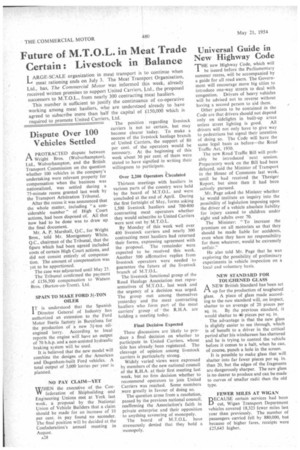Universal Guide in New Highway Code
Page 30

If you've noticed an error in this article please click here to report it so we can fix it.
THE new Highway Code, which will be issued before the Parliamentary summer recess, will be accompanied by a guide for all road users. The Government will encourage more big cities to introduce one-way streets to deal with congestion. Drivers of heavy vehicles will be advised not to reverse without having a second person to aid them.
Other points to be contained in the Code are that drivers should not depend only on sidelights in built-up areas unless street lighting is good. Alt drivers will not only have to give way to pedestrians but signal their intention of doing so. The Code will have the same legal basis as before—the Road Traffic Act, 1930.
The new Road Traffic Bill will probably be introduced next session.
Preparatory work on the Bill had been delayed, said the Minister of Transport in the House of Commons last week, until he had received the Thesiger Report, but since then it had been actively pursued.
Mr. Page asked the Minister whether he would institute an inquiry into the possibility of legislation imposing upon the driver of a vehicle absolute liability for injury caused to children under eight and adults over 70.
The Minister: "To increase the premium on all motorists so that they should be made liable for accidents, even when they have no responsibility for them whatever, would be extremely unfair."
He also told Mr. Page that he was exploring the possibility of preliminary experiments in vehicle inspection on a local and voluntary basis.
NEW STANDARD FOR TOUGHENED GLASS
ANEW British Standard has been set up for the production of toughened glass. A piece of glass made according to the new standard will, on impact, shatter to an average of 20 pieces per
sq. in. By the previous standard, it would shatter to 40 pieces per sq. in. The advantage is that the new glass is slightly easier to see through, which is of benefit to a driver in the critical period after his windscreen has shattered and he is trying to control the vehicle before it comes to a halt, when he can, of course, punch a hole in the screen.
It is possible to make glass that will shatter into far fewer pieces per sq. in. than 20, but the edges of the fragments are dangerously sharper. The new glass is no dearer to produce and can be made to curves of smaller radii than the old type.
FEWERMILES AT WIGAN
nECAUSE certain services had been 1-1 cut, Wigan Transport Department vehicles covered 18,323 fewer miles last year than previously. The number of passengers carried fell by 880,000, but because of higher fares, receipts were £25,643 higher.




















































































